Extraction of Premature Newborns’ Spontaneous Cries in the Real Context of Neonatal Intensive Care Units †
Abstract
:1. Introduction
- The study of the contribution of each original feature to the principal components used for classification;
- A comparison between two training strategies for classification;
- An in-depth analysis of the impact of classification on fundamental frequency estimations for cry characterisation.
2. Materials and Methods
2.1. Databases
2.1.1. Annotated Database
2.1.2. Deployment Database
2.2. Sound Segmentation
2.3. Feature Engineering
2.3.1. Harmonic plus Noise Model Features
2.3.2. Time Features
2.3.3. Synthetic Resume of the Set of Features
2.3.4. Dimensionality Reduction
2.4. Cry/Non-Cry Classification
3. Results
3.1. Identification of the Best Classification Model
3.1.1. Relevance of the Feature Set
3.1.2. Final Retained Sets of Hyper-Parameters
3.1.3. Classification Results on the Test Set
3.2. Evaluation of the Model Performance When Deployed for Monitoring
3.2.1. Evaluation of the Model Classification Performance during Deployment
3.2.2. In-Depth Analysis of the Impact of the Crying Extraction Method on the Analysis of Fundamental Frequency
4. Discussion
5. Conclusions
Author Contributions
Funding
Institutional Review Board Statement
Informed Consent Statement
Data Availability Statement
Conflicts of Interest
References
- World Health Organization. Born Too Soon: The Global Action Report on Preterm Birth; World Health Organization: Geneva, Switzerland, 2012. [Google Scholar]
- Digi-NewB—GCS HUGO—CHU—Monitoring System. Available online: http://www.digi-newb.eu (accessed on 14 April 2020).
- Cabon, S.; Porée, F.; Simon, A.; Rosec, O.; Pladys, P.; Carrault, G. Video and audio processing in paediatrics: A review. Physiol. Meas. 2019, 40, 1–20. [Google Scholar] [CrossRef] [PubMed]
- Manfredi, C.; Bocchi, L.; Orlandi, S.; Spaccaterra, L.; Donzelli, G.P. High-resolution cry analysis in preterm newborn infants. Med. Eng. Phys. 2009, 31, 528–532. [Google Scholar] [CrossRef] [PubMed]
- Shinya, Y.; Kawai, M.; Niwa, F.; Myowa-Yamakoshi, M. Preterm birth is associated with an increased fundamental frequency of spontaneous crying in human infants at term-equivalent age. Biol. Lett. 2014, 10, 20140350. [Google Scholar] [CrossRef] [PubMed]
- Orlandi, S.; Garcia, C.A.R.; Bandini, A.; Donzelli, G.; Manfredi, C. Application of pattern recognition techniques to the classification of full-term and preterm infant cry. J. Voice 2016, 30, 656–663. [Google Scholar] [CrossRef] [PubMed] [Green Version]
- Raboshchuk, G.; Nadeu, C.; Jančovič, P.; Lilja, A.P.; Köküer, M.; Mahamud, B.M.; De Veciana, A.R. A Knowledge-Based Approach to Automatic Detection of Equipment Alarm Sounds in a Neonatal Intensive Care Unit Environment. IEEE J. Transl. Eng. Health Med. 2018, 6, 4400110. [Google Scholar] [CrossRef] [PubMed]
- Naithani, G.; Kivinummi, J.; Virtanen, T.; Tammela, O.; Peltola, M.J.; Leppänen, J.M. Automatic segmentation of infant cry signals using hidden Markov models. EURASIP J. Audio Speech Music. Process. 2018, 2018, 1–14. [Google Scholar] [CrossRef] [Green Version]
- Abou-Abbas, L.; Tadj, C.; Gargour, C.; Montazeri, L. Expiratory and inspiratory cries detection using different signals’ decomposition techniques. J. Voice 2017, 31, 259.e13–259.e28. [Google Scholar] [CrossRef] [PubMed] [Green Version]
- Ferretti, D.; Severini, M.; Principi, E.; Cenci, A.; Squartini, S. Infant Cry Detection in Adverse Acoustic Environments by Using Deep Neural Networks. In Proceedings of the 2018 26th European Signal Processing Conference (EUSIPCO), Rome, Italy, 3–7 September 2018; pp. 992–996. [Google Scholar]
- Cabon, S.; Met-Montot, B.; Porée, F.; Rosec, O.; Simon, A.; Carrault, G. Automatic extraction of spontaneous cries of preterm newborns in neonatal intensive care units. In Proceedings of the 2020 28th European Signal Processing Conference (EUSIPCO), Virtual, 18–22 January 2021; pp. 1200–1204. [Google Scholar]
- Cabon, S.; Porée, F.; Cuffel, G.; Rosec, O.; Geslin, F.; Pladys, P.; Simon, A.; Carrault, G. Voxyvi: A system for long-term audio and video acquisitions in neonatal intensive care units. Early Hum. Dev. 2021, 153, 105303. [Google Scholar] [CrossRef] [PubMed]
- Abou-Abbas, L.; Alaie, H.F.; Tadj, C. Automatic detection of the expiratory and inspiratory phases in newborn cry signals. Biomed. Signal Process. Control 2015, 19, 35–43. [Google Scholar] [CrossRef] [Green Version]
- Orlandi, S.; Manfredi, C.; Bocchi, L.; Scattoni, M. Automatic newborn cry analysis: A non-invasive tool to help autism early diagnosis. In Proceedings of the Engineering in Medicine and Biology Society (EMBC), 2012 Annual International Conference of the IEEE, San Diego, CA, USA, 28 August–1 September 2012; pp. 2953–2956. [Google Scholar]
- Otsu, N. A threshold selection method from gray-level histograms. IEEE Trans. Syst. Man Cybern. 1979, 9, 62–66. [Google Scholar] [CrossRef] [Green Version]
- Manfredi, C.; Bandini, A.; Melino, D.; Viellevoye, R.; Kalenga, M.; Orlandi, S. Automated detection and classification of basic shapes of newborn cry melody. Biomed. Signal Process. Control 2018, 45, 174–181. [Google Scholar] [CrossRef]
- Stylianou, Y. Harmonic Plus Noise Models for Speech, Combined with Statistical Methods, for Speech and Speaker Modification. Ph.D Thesis, Ecole Nationale Superieure des Telecommunications, Paris, France, 1996. [Google Scholar]
- Orlandi, S.; Guzzetta, A.; Bandini, A.; Belmonti, V.; Barbagallo, S.D.; Tealdi, G.; Mazzotti, S.; Scattoni, M.L.; Manfredi, C. AVIM—A contactless system for infant data acquisition and analysis: Software architecture and first results. Biomed. Signal Process. Control 2015, 20, 85–99. [Google Scholar] [CrossRef]
- Várallyay, G. Future prospects of the application of the infant cry in the medicine. Period. Polytech. Electr. Eng. 2006, 50, 47–62. [Google Scholar]
- Várallyay, G. The melody of crying. Int. J. Pediatr. Otorhinolaryngol. 2007, 71, 1699–1708. [Google Scholar] [CrossRef] [PubMed]
- Coelho, L.P.; Richert, W. Building Machine Learning Systems with Python; Packt Publishing Ltd.: Birmingham, UK, 2015. [Google Scholar]
- Jolliffe, I. Principal Component Analysis; Springer: Berlin/Heidelberg, Germany, 2011. [Google Scholar]
- Baken, R.J.; Orlikoff, R.F. Clinical Measurement of Speech and Voice; Cengage Learning: Boston, MA, USA, 2000. [Google Scholar]
- Cabon, S.; Porée, F.; Simon, A.; Met-Montot, B.; Pladys, P.; Rosec, O.; Nardi, N.; Carrault, G. Audio-and video-based estimation of the sleep stages of newborns in Neonatal Intensive Care Unit. Biomed. Signal Process. Control 2019, 52, 362–370. [Google Scholar] [CrossRef] [Green Version]
- Met-Montot, B.; Cabon, S.; Carrault, G.; Porée, F. Spectrogram-based fundamental frequency tracking of spontaneous cries in preterm newborns. In Proceedings of the 2020 28th European Signal Processing Conference (EUSIPCO), Virtual, 18–22 January 2021; pp. 1185–1189. [Google Scholar]
- Ayesha, S.; Hanif, M.K.; Talib, R. Overview and comparative study of dimensionality reduction techniques for high dimensional data. Inf. Fusion 2020, 59, 44–58. [Google Scholar] [CrossRef]
- Xie, J.; Long, X.; Otte, R.A.; Shan, C. Convolutional neural networks for audio-based continuous infant cry monitoring at home. IEEE Sens. J. 2021, 21, 27710–27717. [Google Scholar] [CrossRef]
- Jindal, S.; Nathwani, K.; Abrol, V. Classification of Infant Behavioural Traits using Acoustic Cry: An Empirical Study. In Proceedings of the 2021 12th International Symposium on Image and Signal Processing and Analysis (ISPA), Zagreb, Croatia, 13–15 September 2021; pp. 97–102. [Google Scholar]
- Salekin, M.S.; Zamzmi, G.; Goldgof, D.; Kasturi, R.; Ho, T.; Sun, Y. Multimodal spatio-temporal deep learning approach for neonatal postoperative pain assessment. Comput. Biol. Med. 2021, 129, 104150. [Google Scholar] [CrossRef] [PubMed]
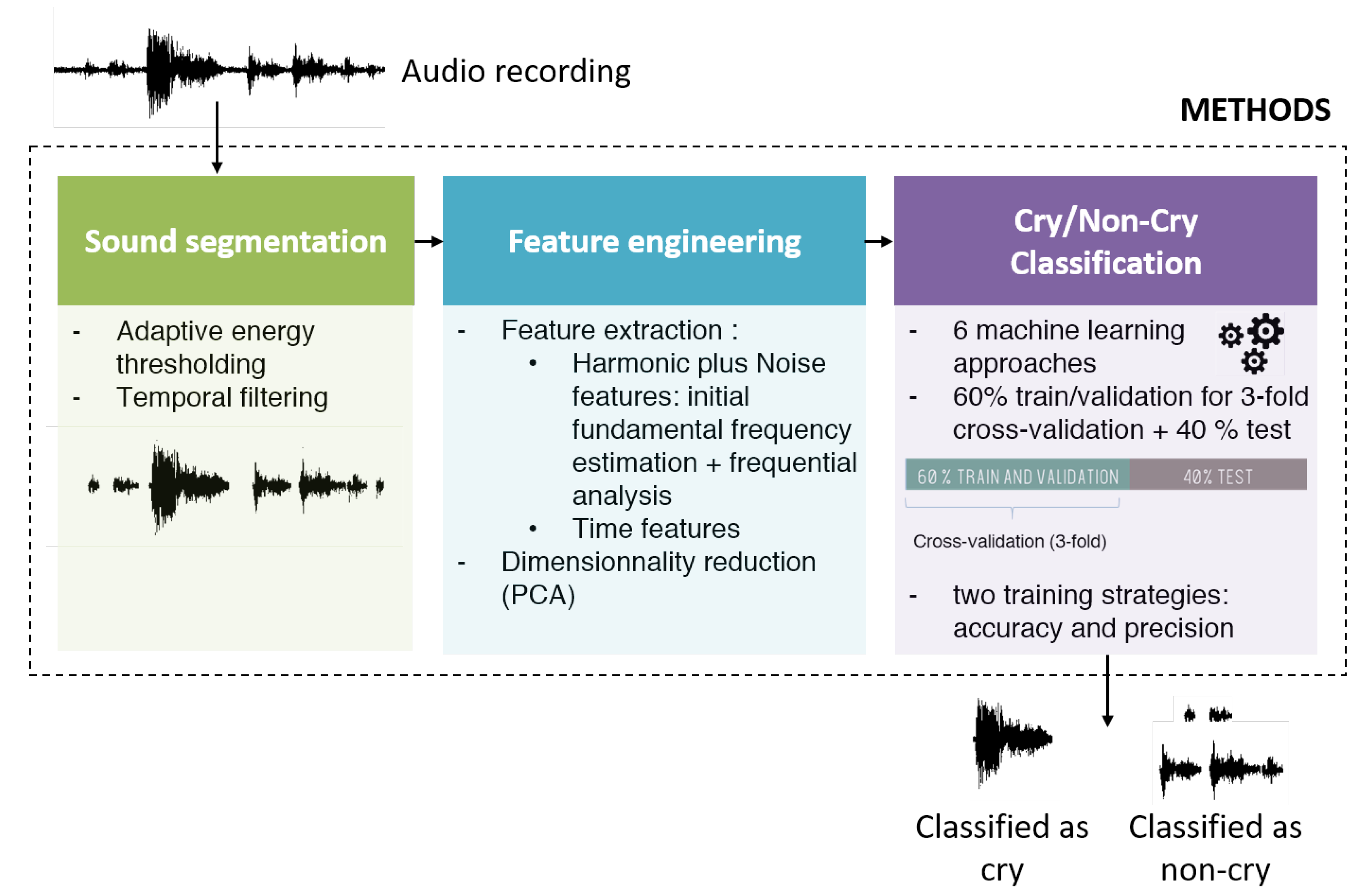
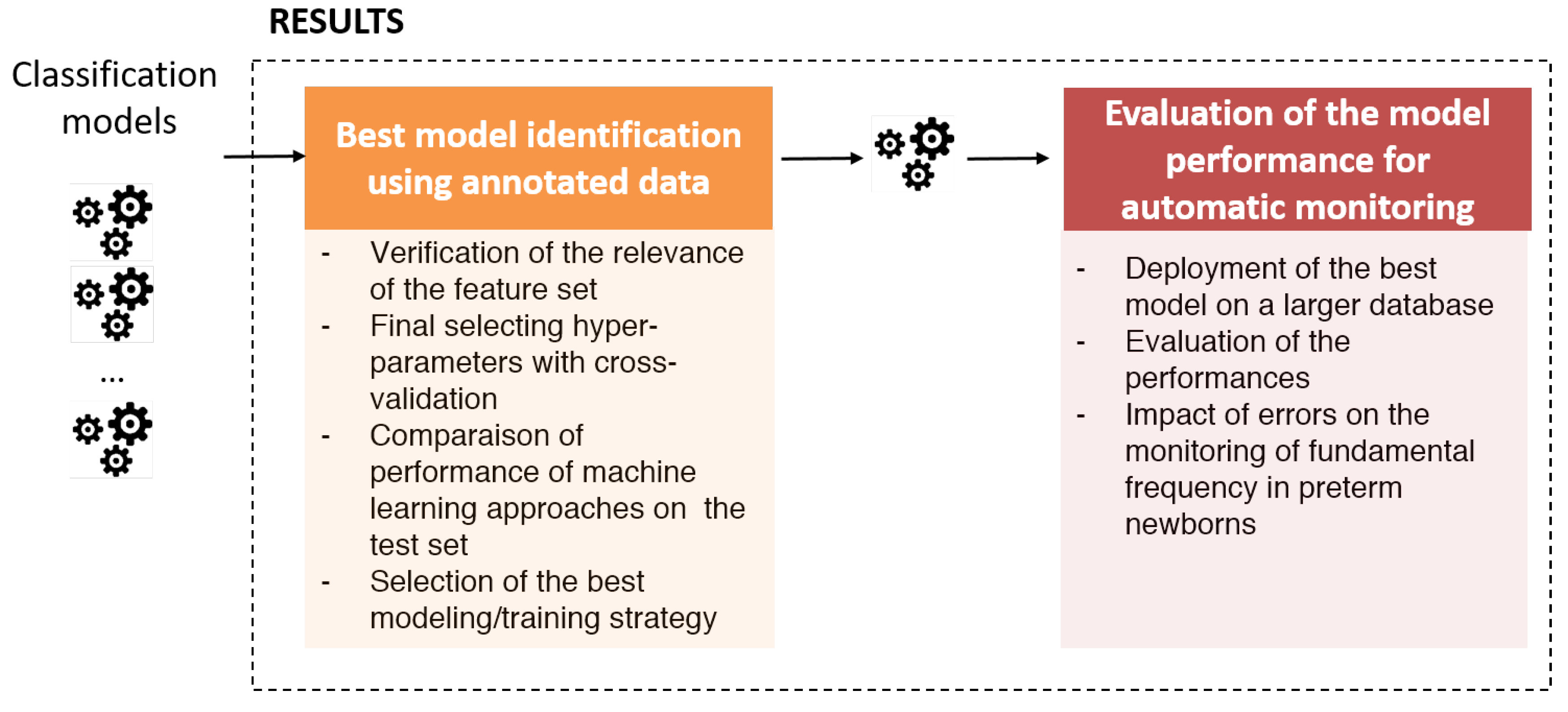
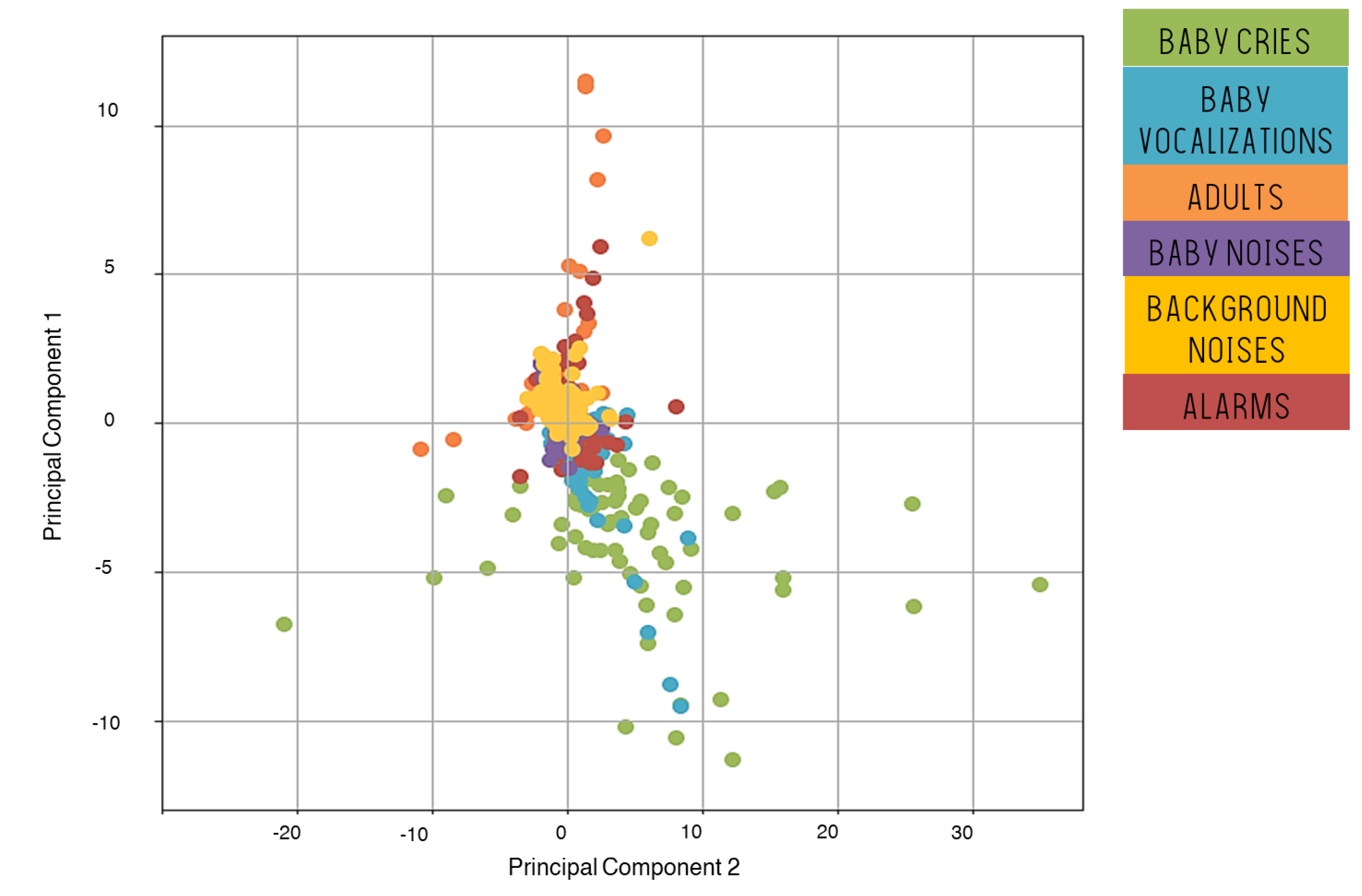
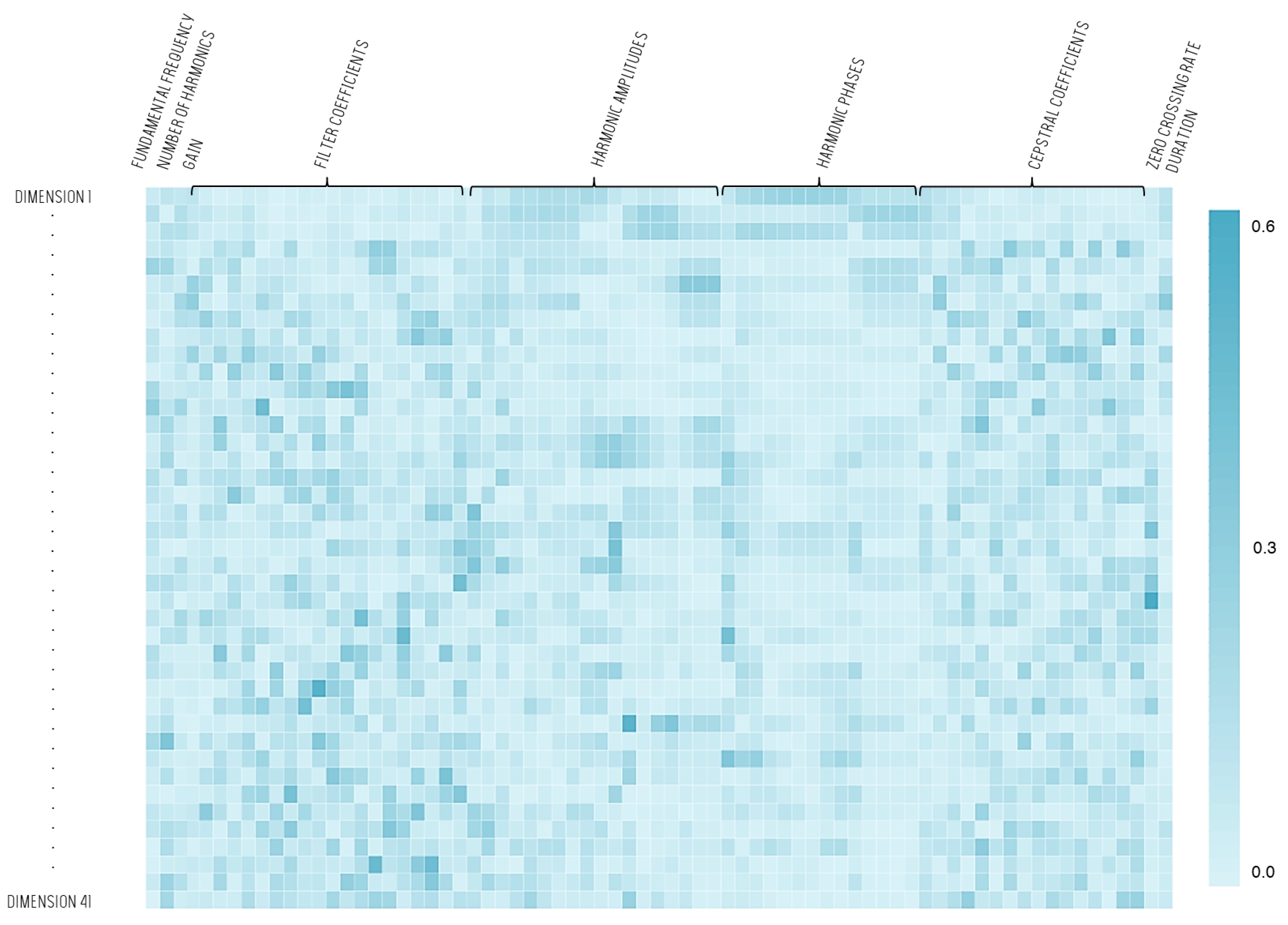




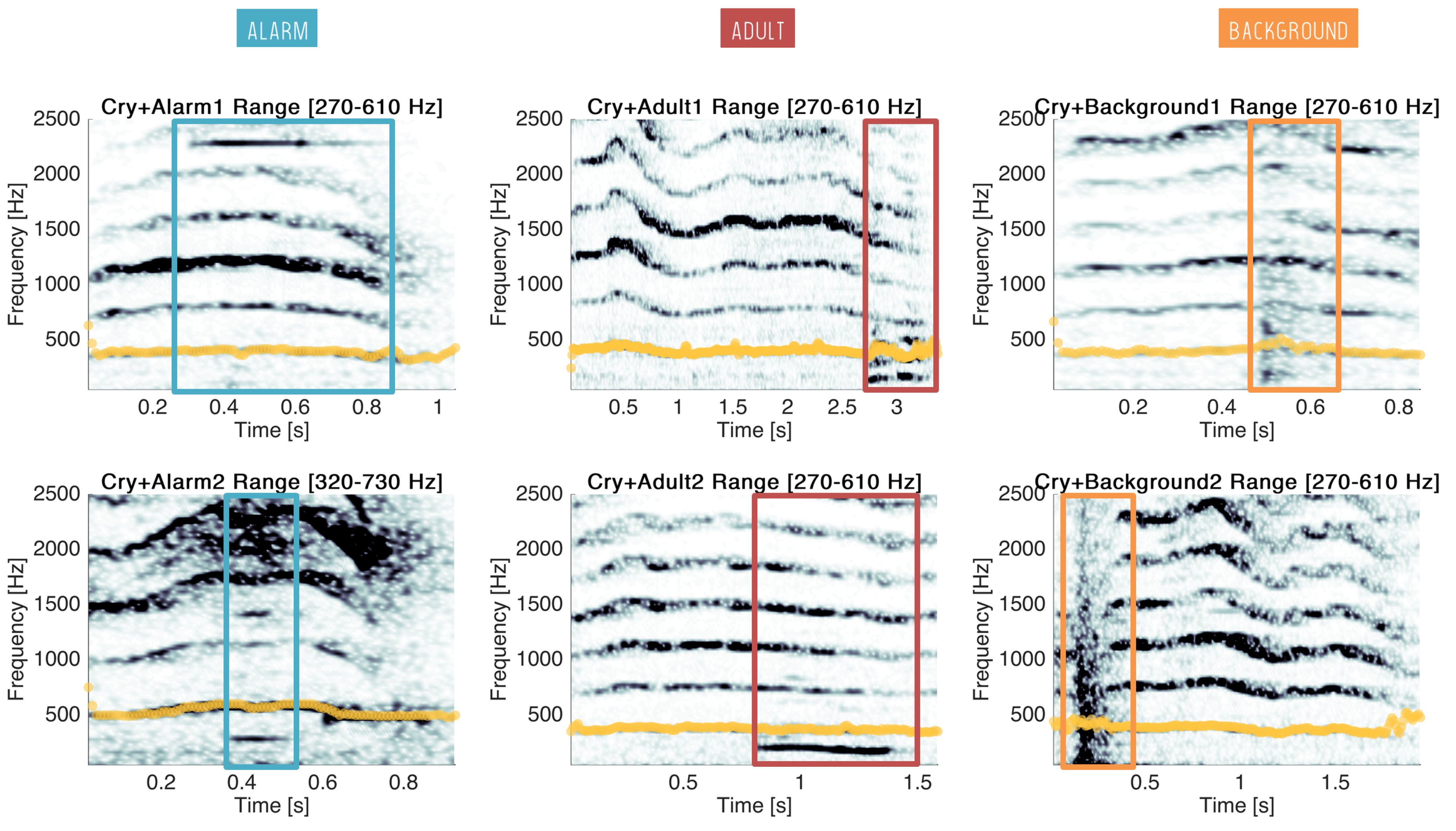


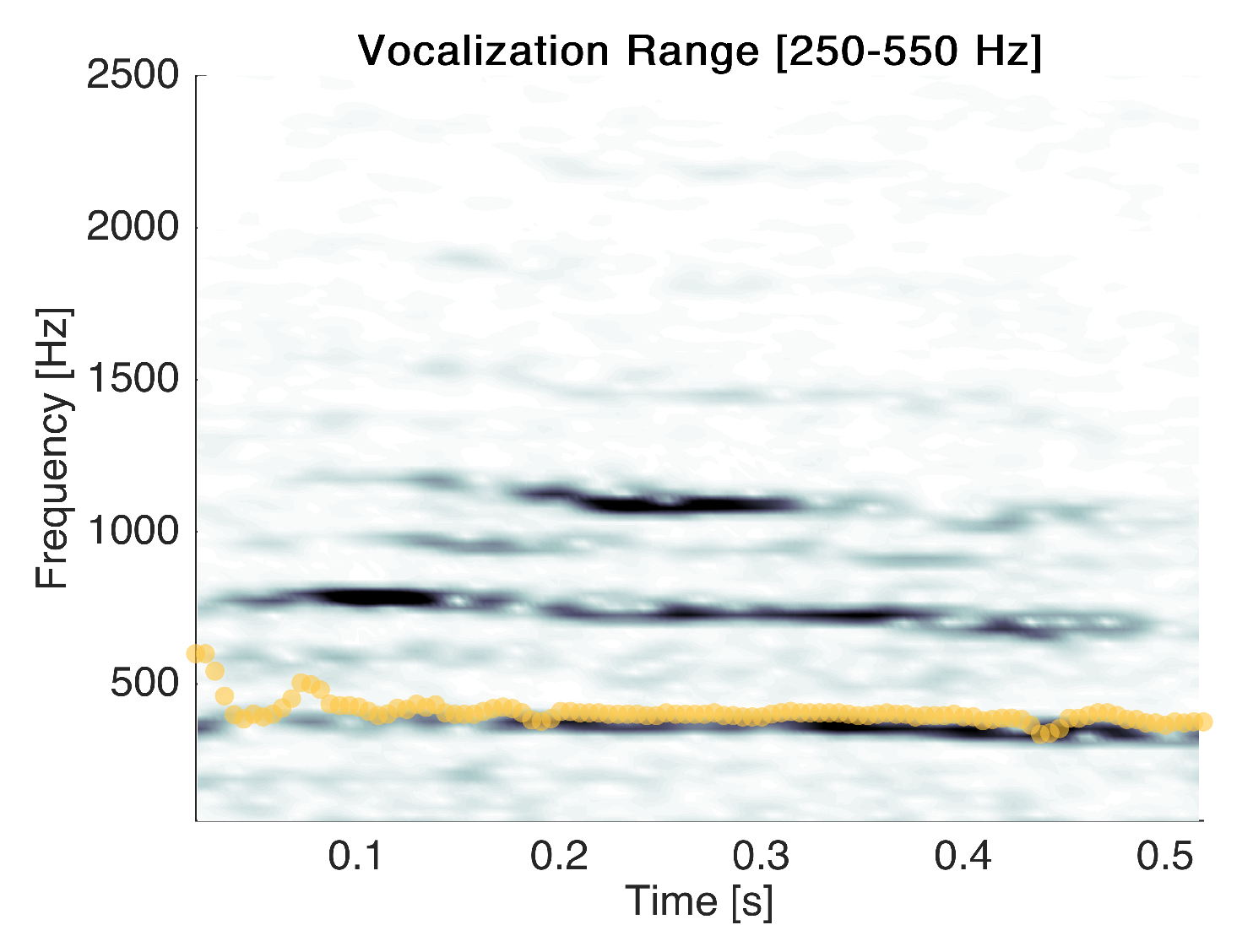

| Type of Feature | Estimation Method | Number of Instances |
|---|---|---|
| Fundamental frequency | HNM | 1 |
| Number of harmonics | HNM | 1 |
| Harmonic amplitudes | HNM | 18 |
| Harmonic phases | HNM | 14 |
| Gain | HNM | 1 |
| Filter coefficients | HNM | 20 |
| Mel-Frequency Cepstral Coefficients | HNM | 16 |
| Zero crossing rate | ZCR | 1 |
| Duration | Duration | 1 |
| Method | Parameters |
|---|---|
| KNN | Number of neighbors ∈ [1, 3, 5, 11, 15] |
| Distance: Manhattan or Euclidean | |
| LDA | Solver ∈ [singular value decomposition, |
| least squares solution, eigenvalue decomposition] | |
| LR | Cut-off ∈ [0.1, 0.2, 0.5, 0.7] |
| RF | Number of trees ∈ [5, 10, 20, 50, 100, 300] |
| Quality split criterion: gini or entropy | |
| MLP | Number of hidden layers ∈ [ 1, 2, 5] |
| Number of perceptrons per layers ∈ [1, 2, 5, 10, 20, 30] | |
| Activation function ∈ [identity, logistic sigmoid, | |
| hyperbolic tan, rectified linear unit] | |
| SVM linear | No additional parameter |
| SVM polynomial | degree ∈ [1, 2, 3, 4] |
| SVM gaussian | margin ∈ [0.01, 0.1, 1, 10, 100, 10, 10] |
| gamma ∈ [0.0001, 0.001, 0.01, 0.1, 1, 5, 10, 100] |
Publisher’s Note: MDPI stays neutral with regard to jurisdictional claims in published maps and institutional affiliations. |
© 2022 by the authors. Licensee MDPI, Basel, Switzerland. This article is an open access article distributed under the terms and conditions of the Creative Commons Attribution (CC BY) license (https://creativecommons.org/licenses/by/4.0/).
Share and Cite
Cabon, S.; Met-Montot, B.; Porée, F.; Rosec, O.; Simon, A.; Carrault, G. Extraction of Premature Newborns’ Spontaneous Cries in the Real Context of Neonatal Intensive Care Units. Sensors 2022, 22, 1823. https://doi.org/10.3390/s22051823
Cabon S, Met-Montot B, Porée F, Rosec O, Simon A, Carrault G. Extraction of Premature Newborns’ Spontaneous Cries in the Real Context of Neonatal Intensive Care Units. Sensors. 2022; 22(5):1823. https://doi.org/10.3390/s22051823
Chicago/Turabian StyleCabon, Sandie, Bertille Met-Montot, Fabienne Porée, Olivier Rosec, Antoine Simon, and Guy Carrault. 2022. "Extraction of Premature Newborns’ Spontaneous Cries in the Real Context of Neonatal Intensive Care Units" Sensors 22, no. 5: 1823. https://doi.org/10.3390/s22051823
APA StyleCabon, S., Met-Montot, B., Porée, F., Rosec, O., Simon, A., & Carrault, G. (2022). Extraction of Premature Newborns’ Spontaneous Cries in the Real Context of Neonatal Intensive Care Units. Sensors, 22(5), 1823. https://doi.org/10.3390/s22051823






